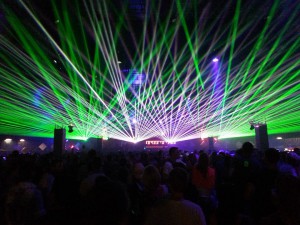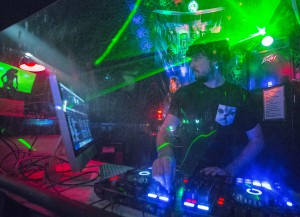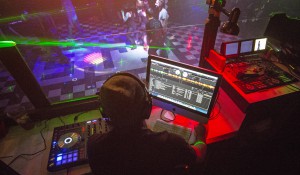Popularized by artists such as Calvin Harris, Deadmau5 and David Guetta, EDM, or electronic dance music, is beat-driven music produced for dance-based entertainment.
“There’s a huge demand for it,” said Moscow deejay Nick Cain, or CnDyCain, who produced a documentary on EDM for his Dance 100 class at the University of Idaho. “It’s a passion, because it’s very upbeat, and very positive lyrically.”
Cain mainly deejays at CJ’s Nightclub in Moscow, but with his EDM-heavy beats, his deejaying has grown in demand.
“I’m booking gigs every other week at CJ’s, as well as at private events on campus,” said Cain who has performed on both the UI and WSU campuses.
Jacob Farris, WSU Student Entertainment Board director, said he hears people listening to EDM on campus and playing hits at parties.
“People are getting more into the music,” Farris said. “My freshman year of college, it was starting to become more popular, and now that I’m a senior, more people are listening to it.”
By the mid-1990s, producers were able to create EDM-based music after the introduction of MIDI interfaces and personal computers, but it wasn’t until the early 2000s that sound manipulation progressed and computer software technology was advanced enough to allow EDM studios just about anywhere.
With EDM growing in popularity, Farris said, it was a great opportunity for the entertainment board to expand the musical genres it offers for concerts. In early October, 3LAU, or Justin Blau, performed at WSU, and Adventure Club performed Oct. 29.
Farris previously saw Adventure Club live at Paradiso Festival in the Gorge Amphitheater and said there was a large turnout.
Cain attended Paradiso this year, too, as well as the festivals Lucky and Massive. He said EDM festivals are often stereotyped as having a lot of drug use (see accompanying story below).
“But I’ve had good experiences at every fest I’ve been to,” he said.
Everybody Cain met was polite, he said.
“You’re with 23,000 people. If someone (accidentally) punches you in the back of the head, the guy has a look of shock … He apologizes and you chat with him for two or three minutes,” said Cain, laughing.
But EDM has a home at more than just festivals. Cain deejayed at a WSU residence hall for a back-to-school mixer, and CJ’s Nightclub is host to hundreds of EDM fans each weekend.
“Mainly what got me into deejaying was that music,” Cain said. “At CJ’s, it’s a balance of playing the hip hop and top 30 songs, and the upbeat, hotter tracks that EDM has, too.”
The Zzu Bar and Grill manager Alfredo Bautista, though, said his DJs stick with top 40s, not EDM.
With a shortage of EDM at Pullman’s only dance club, fans flooded Adventure Club’s WSU performance. Tickets sold out within the first week of the student-only event.
As far as small concerts supported by the UI’s Vandal Entertainment, no EDM groups are scheduled.
“I’m a little jealous I don’t have the opportunity to go see (Adventure Club),” Cain said. “I see Pullman making more and more of a pull, and I really wish UI would follow suit.”
While EDM has made waves locally, it seems that EDM addicts may have to settle for traveling to national festivals or Spokane — which is host to Morgan Page’s 3D Visual Experience on Saturday — to get their fix.
“It’s a change in what kind of music people are listening to,” Farris said. “You have your typical hip hop, rock. Our generation is getting more influence into this music.”
EDM and MDMA
WSU graduate Patrick Witkowski, 21, died after a brain hemorrhage from supposed MDMA consumption at the late June festival, Paradiso. MDMA is an empathogenic drug, known as ecstasy, or now popularly dubbed “Molly.” In the coroner’s report last week, though, autopsy results finally revealed that his death was related to methamphetamine, not Molly.
Chelan County Coroner Wayne Harris said he had been working on the assumption the death was due to an MDMA overdose, but the results showed Witkowski died of organ failure due to a combination of dehydration, heat and meth intoxication.
Witkowski was one of more than 70 Paradiso attendees who had been treated at Quincy Valley Medical Center during a three-day span, and between 40 and 50 of those cases involved alcohol or drug abuse, hospital spokeswoman Michele Wurl told the Moscow-Pullman Daily News in July.
At the Electric Zoo EDM festival in New York this September, three people died from Molly-induced dehydration, according to Seattle Weekly, resulting in cancellation of the event’s last day.
“The drug’s appeal is the euphoria it produces, which users often say makes the feeling of togetherness and the intensity of EDM much greater at raves,” Seattle Weekly reported on Oct. 16. “The problem is, the drug is often cut with other substances like methamphetamine, ketamine and PMMA, a cheap cousin of MDMA with less euphoric effect but more of the toxicity that can result in deadly hyperthermia.”
What does EDM sound like?
You’ve probably heard it if you’ve ever been in a dance club: The deejay segues from one song or record to the next with a synchronized beat, hopefully in a seamless transition. But what’s the difference between dubstep, techno, house music and EDM? While some say EDM is the same as all the genres listed above, some call them subgenres of EDM, and others separate it completely. It seems, no one really knows how to describe what music fits in the category, but here’s a few EDM genres broken down by the website, EDM Sauce:
 HOUSE:
Known as the most ‘human’ sounding music of all genres, it’s often
heard in Top 40 mixes, by artists such as Daft Punk or Tiesto.
HOUSE:
Known as the most ‘human’ sounding music of all genres, it’s often
heard in Top 40 mixes, by artists such as Daft Punk or Tiesto.TRANCE: Trance uses melodic tunes and repetitive synthesizer progressions. It’s usually played between 125 to 150 beats per minute.
TECHNO: Sometimes used interchangeably with EDM, techno is generally a repetitive beat in common time, using drum machines, snyths and digital workstations.
DUBSTEP: A production using strong bass lines, drum patterns and occasional vocals, dubstep was made famous by artists such as Skrillex, and is a bit more aggressive than techno.
As seen in the Nov. 14 issue of Inland 360.


No comments:
Post a Comment